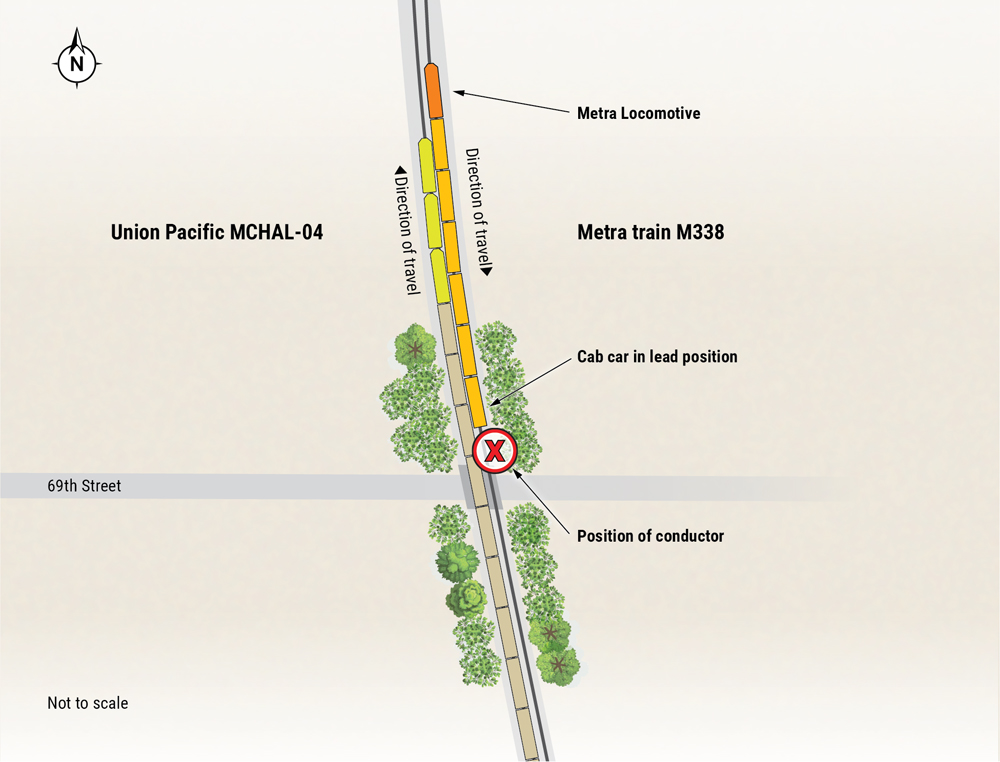
WASHINGTON — The Union Pacific conductor struck and killed by a Metra train in Kenosha, Wis., on Sept. 4 had left the locomotive of his freight train to address a hot-wheel report from a wayside detector, the National Transportation Safety Board says in am preliminary investigation report issued today (Tuesday, Oct. 1).
The incident occurred about 12:11 p.m. local time at milepost 50.5 of UP’s Kenosha Subdivision, about a half-mile south of the Metra station in Kenosha [see “Union Pacific worker struck, killed …,” Trains News Wire, Sept. 4, 2024]. News reports identified the worker killed as 34-year-old Austin Scott Raysby of Burlington, Wis.
A detector had indicated a problem with the 51st car of UP train MCHAL-04, leading to the train being stopped on Main Track 1. The conductor walked across Main Track 2 and had the engineer move the train forward so he could inspect the car in question. While he waited to examine the suspected hot wheel, Metra train 338, with its cab car leading, rounded the curve and struck the conductor.
Union Pacific issued a safety alert the next day to brief employees on the accident and review relevant operating and safety rules. The ongoing NTSB investigation will focus on adjacent track protection rules where changes may possibly mitigate the risk for train crews on the ground.














I went onto Google Maps and manipulated the satellite image using the mouse with the Ctrl key and it’s a seems to be a bigger curve than what the NTSB image above portrays. Without getting into human factors, the mitigating factors are the trees casting shade upon the tracks and the quieter cab car leading.
From the report “On September 4, 2024, about 12:11 p.m. local time, the conductor of northbound Union Pacific Railroad (UP) train MCHAL-04 was struck and killed by southbound Northern Illinois Regional Commuter Rail Corporation (METRA) commuter train M338 at milepost 50.5 of the UP Kenosha Subdivision near Kenosha, Wisconsin. (See figure.) There were no other reported fatalities or injuries. At the time of the accident, and the temperature was 79°F with no precipitation. Although skies were clear with midday light, visibility was impeded by a grove of trees beside the tracks on the southern half of the curve.”
https://www.ntsb.gov/investigations/Pages/RRD24FR016.aspx
Not nearly enough info to comment accurately on this sad incident. The Metra train rounding a curve but the diagram shows a minimal curve and the Metra engineer would have had a clear sight line . The diagram shows shrubbery along the r-o-w, is it so close or dense that the conductor was walking on the tracks? How close was car 51 getting to him, was he paying attention to the car count and not the surroundings?
The lack of communication the biggest error.
Two things bother me about this. The big one is was there no communication between him and the engineer? His engineer should have warned him of an approaching train. And what about the engineer contacting the Metra train? In my career I always warned my conductor of a hot rail and let the crew of the approaching train know my conductor was on the ground. Whenever I was alerted by a stopped train that their conductor was on the ground I would slow down, ring the bell and frequently sound the horn. Often that conductor would contact me via radio and let me know they were in the clear. Situational awareness and crew communication appear to be lacking here.
JAMES — Normaly I never comment on incidents, as I haven’t read the incident reports nor have I any training in rail safety. That’s normally. This one isn’t normal. It doesn’t pass the smell test. Rail employees know to expect a train at any time on any track in either direction, scheduled or otherwise. So the conductor knew better than to occupy the envelope unless explicitly told it was safe. So he must have been told it was safe — though it wasn’t.